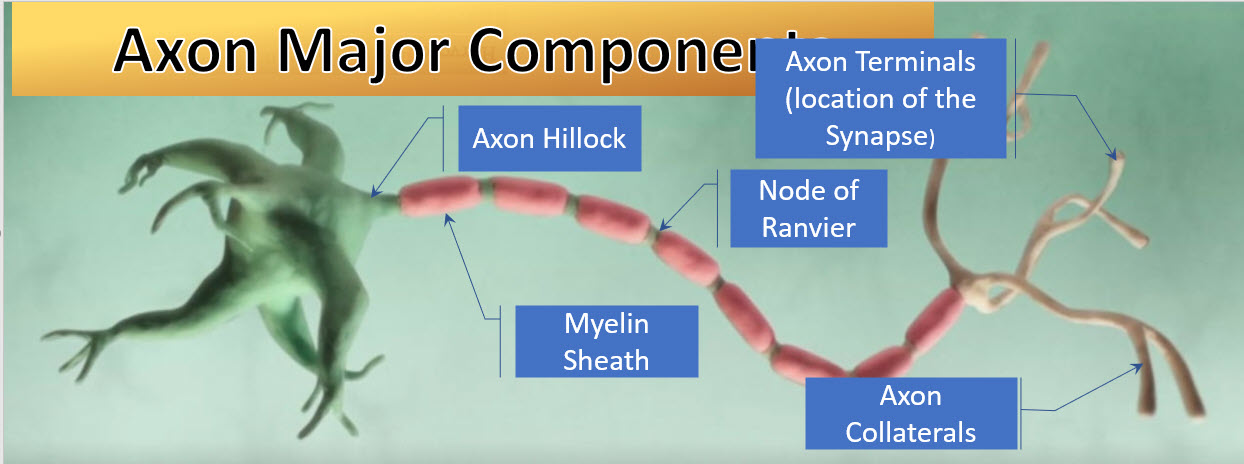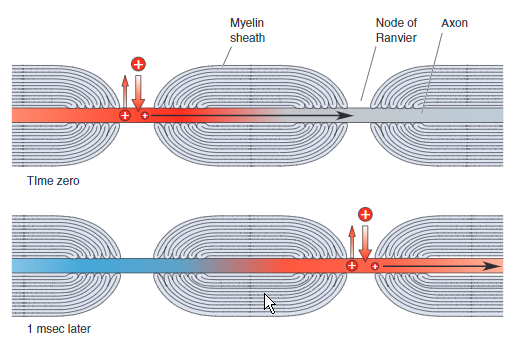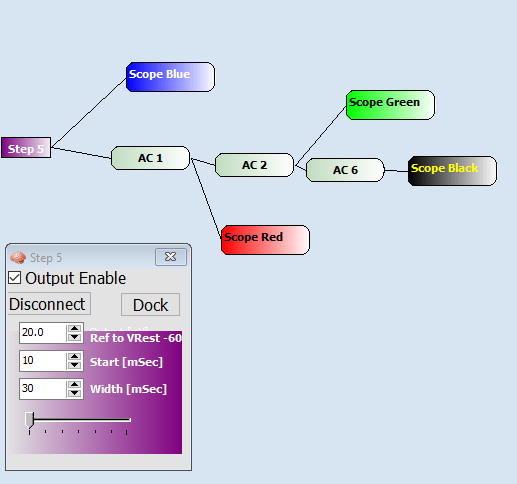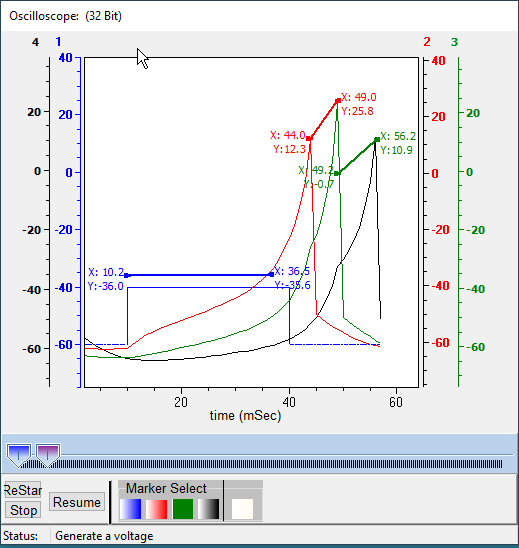The Axon

Google Search of SETI Net
The Axon is a structure that is found only in neurons. It is highly specialized for the transfer of information over long distances in the nervous system. The Axon begins with a region called the Axon Hillock in the Soma body and tapers to form the initial segment of the Axon.
Axons may extend from less than a millimeter to well over a meter and often branch. These branches are called axon collaterals. Occasionally, an axon collateral will return to communicate with the same cell that gave rise to the Axon. This type of axon branches is called a 'recurrent collateral.'
The tip of each Axon Collateral is where the synapses are formed. Synapse operation is covered extensively in standard textbooks and classes but are not part of the NeuronLab simulator except as described in 4. Synapse and Dendrites.
Glia cells (not shown) provid layers of membrane that insulate axons. This wrapping, called myelin, spirals around axons and provide insulation to the Action Potential that travels down the Axon.

The myelin sheath does not extend continuously along the entire length of the axon. There are breaks in the insulation where ions cross the membrane to generate action potentials. The breaks in the myelin sheath are called the nodes of Ranvier and act as relay points for the action potential as it moves down the axon chain. Voltage-gated sodium channels are concentrated in the membrane of these nodes.
In the human femoral nerve the primary sensory axon is approximately 0.5 m long and the internodal distance is 1 to 1.5 mm; thus approximately 300 to 500 nodes of Ranvier occur along a primary afferent fiber between the thigh muscle and the cell body in the dorsal root ganglion.[Kandel page 152 *]
The distance between nodes of Ranvier is usually 0.2–2.0 mm, depending on the axon size (fatter axons have larger inter-nodal distances).
The myelination thickness affects the conduction velocity of the axon. The following table is a guideline[Kandel page 412 *]
| Diameter (uM) | Conduction Velocy (M/Sec | ||
|---|---|---|---|
| Smallest | 0.2-1.5 | 0.4-2.0 | Unmyelinated |
| Small | 1-6 | 4-36 | |
| Medium | 6-12 | 36-72 | |
| Large | 12-20 | 72-120 |
If you have not done so already download and install the SETI Net NeuronLab Simulator here.
The Axon experiment using the NeuronLab Simulator
Video of a the flow of a spike through three axon compartments.
This experiment shows the flow of a spike of initial current moving down the length of three Axon compartments. Four oscilloscope probes are used to monitor the flow. The video was collected from the simulation running the body plan shown below.
Steps:
- Start the simulator, add components and arrange them approximately as shown in the figure below
- Make the connections using left clicks. The simulator should start operation
- Right click on the Step input you have chosen (Step 5 in this example) and set it parameters as shown.
- Adjust the sliders on the Oscilloscope to approximately the position shown
- Using the markers on the Oscilloscope measure the time difference between the leading edge on the step input and the mid point of the first 'scope (red) track. Log your reading.
- manipulate the parameters on the Step function to see the effect of pulse width on the spike as it moves through the chain of axons.
- Each compartment simulates the spiking action of the neuron Soma. Right click on an axon icon and change spiking type. Try 'Chattering'.
You will find it easer to use the 'Scopes Pause At button to apply the marker measurements


| Component | Start | Stop |
Delay Times |
|---|---|---|---|
| Step input | 10 | 30 | 20 mS |
| AC 1 fire point | 10.2 | 36.5 | 26.3 mS |
| AC1 to AC2 | 40.0 | 49.0 | 9 mS |
| AC2 to AC3 | 49.2 | 56.2 | 7 mS |
